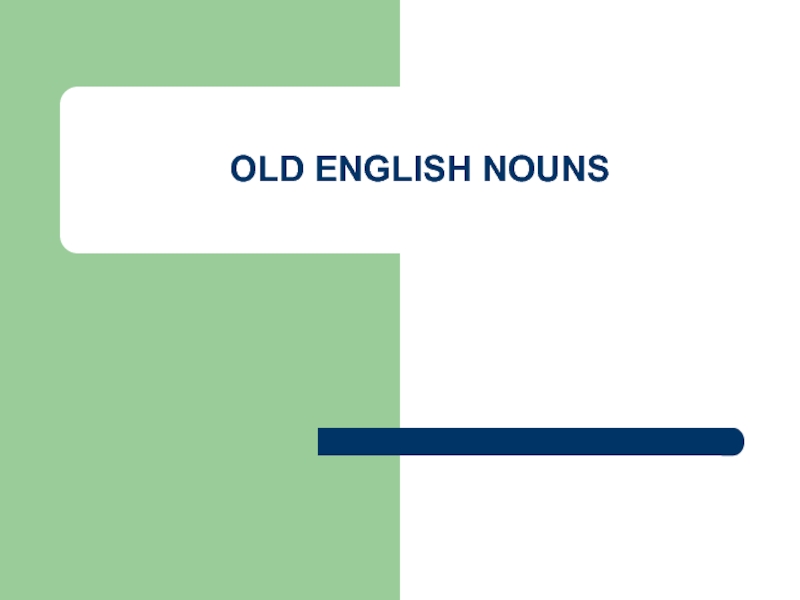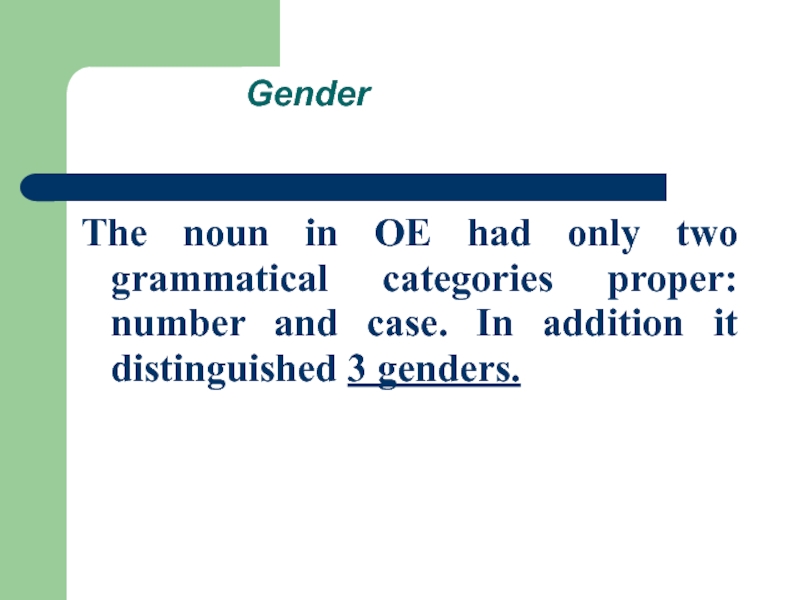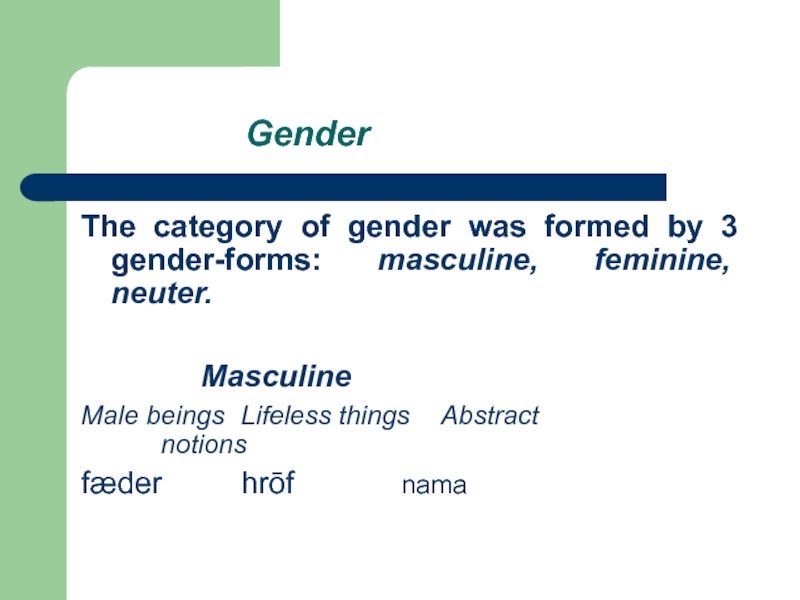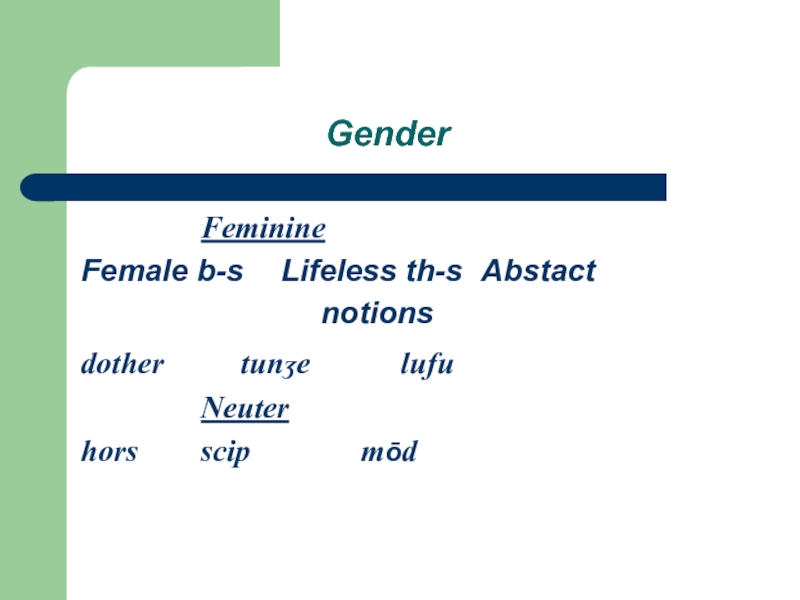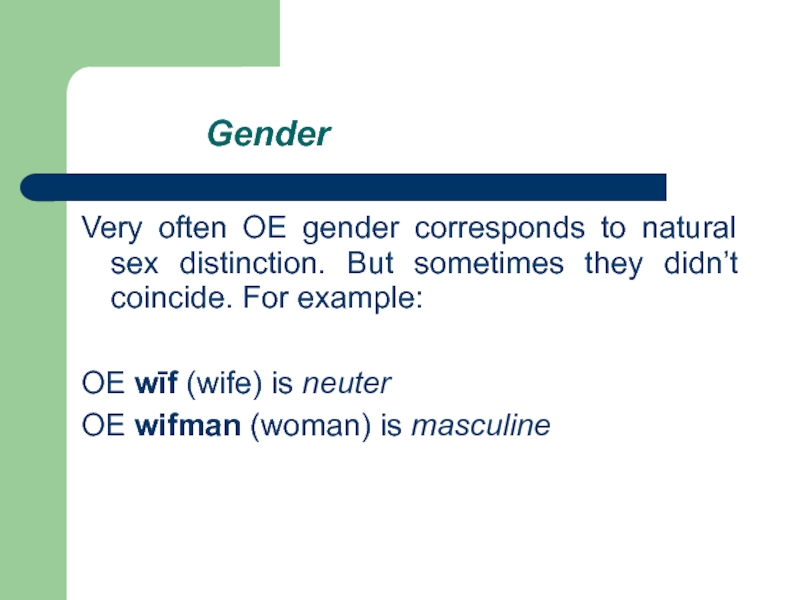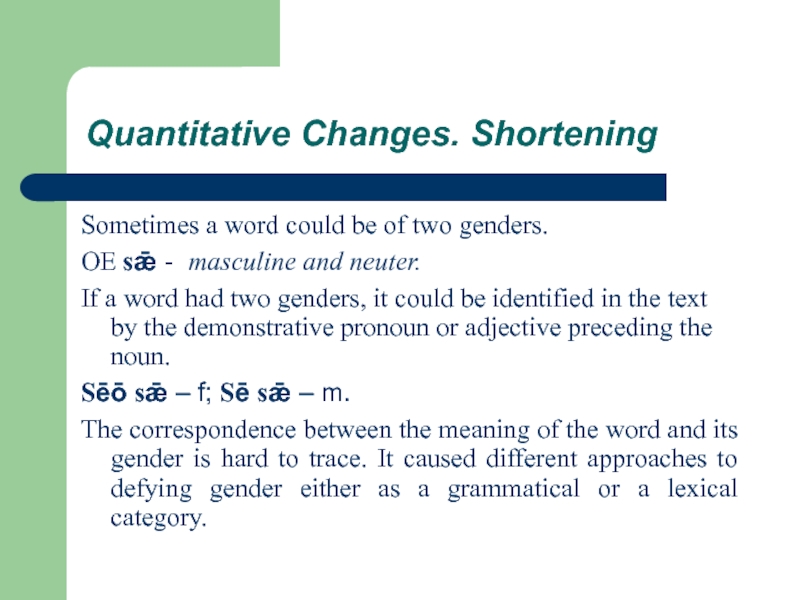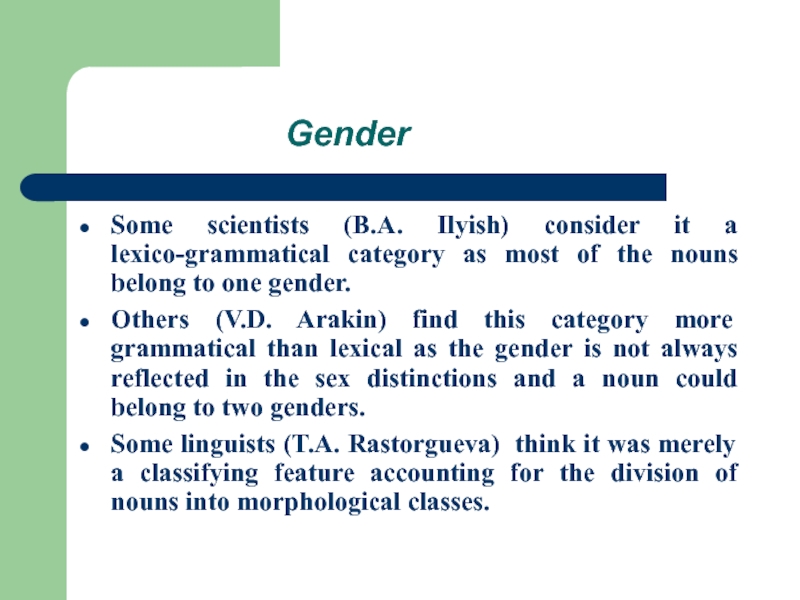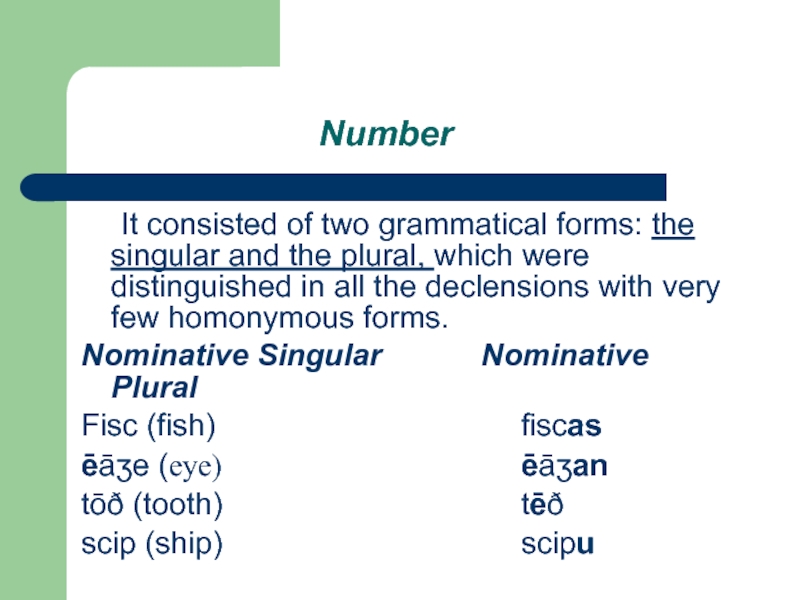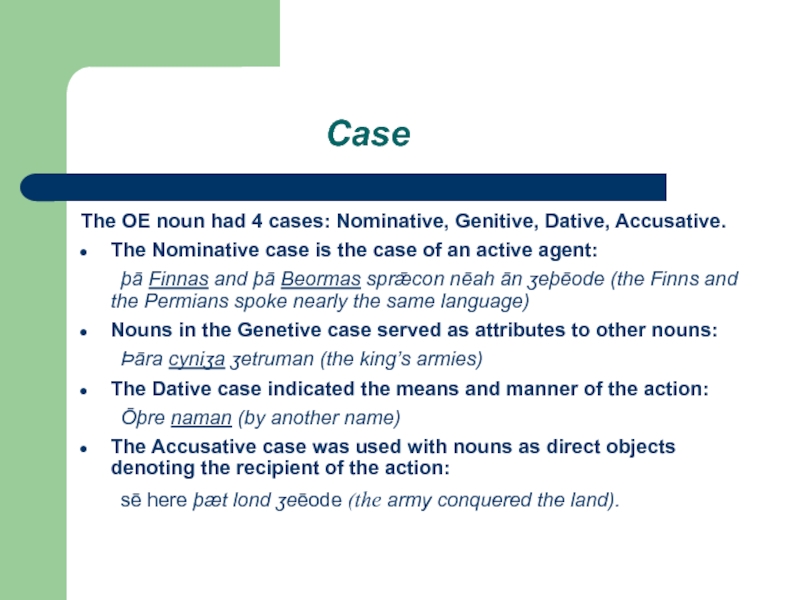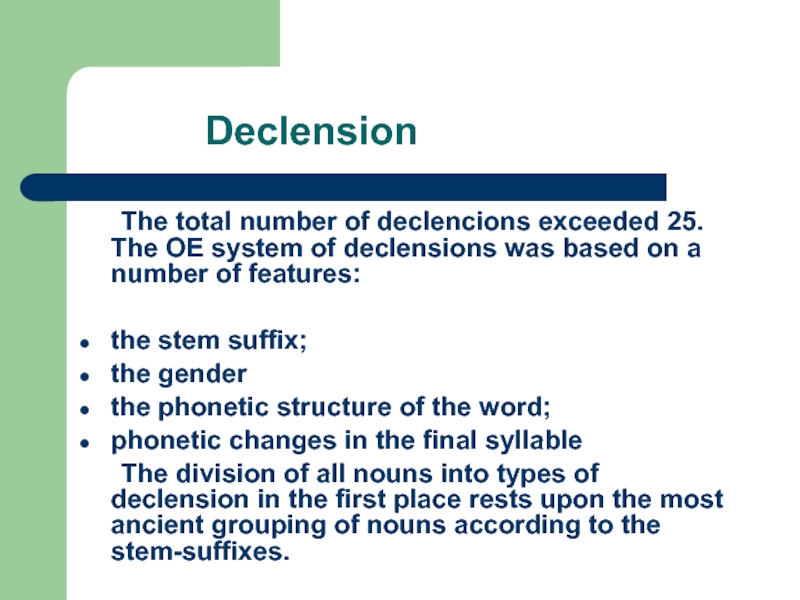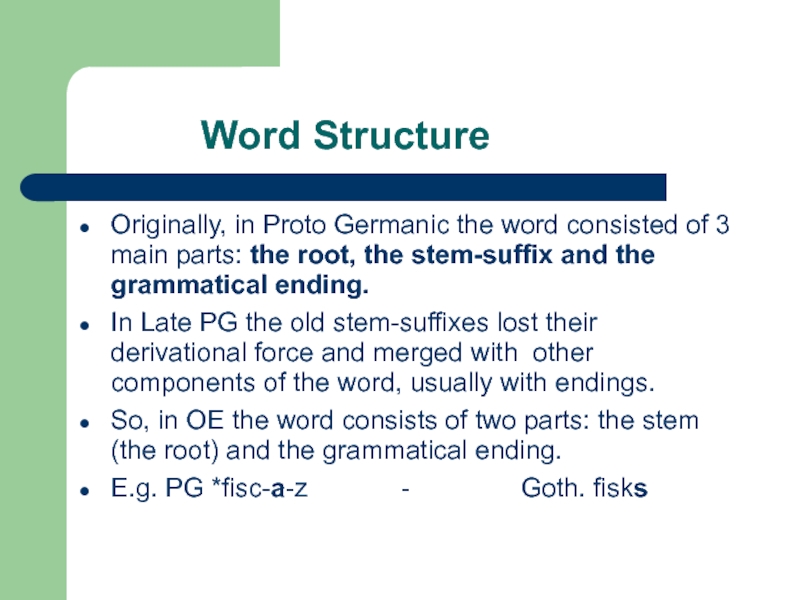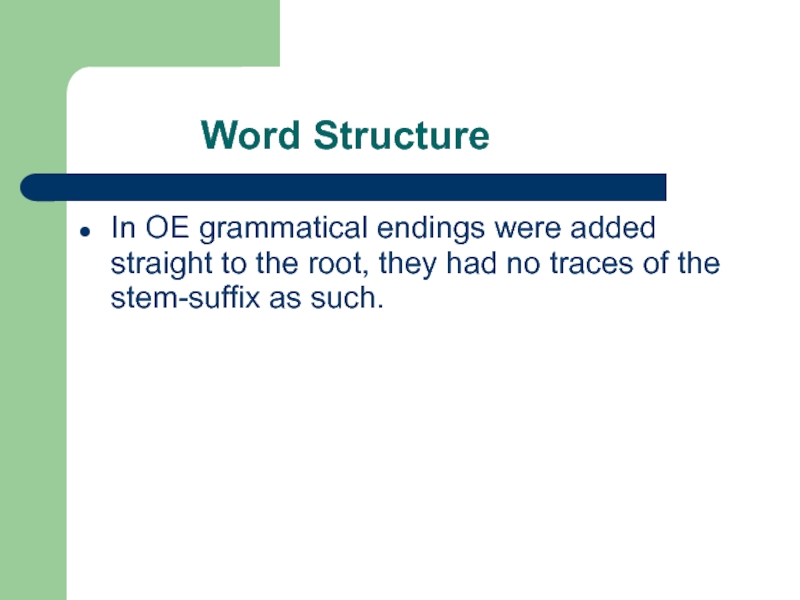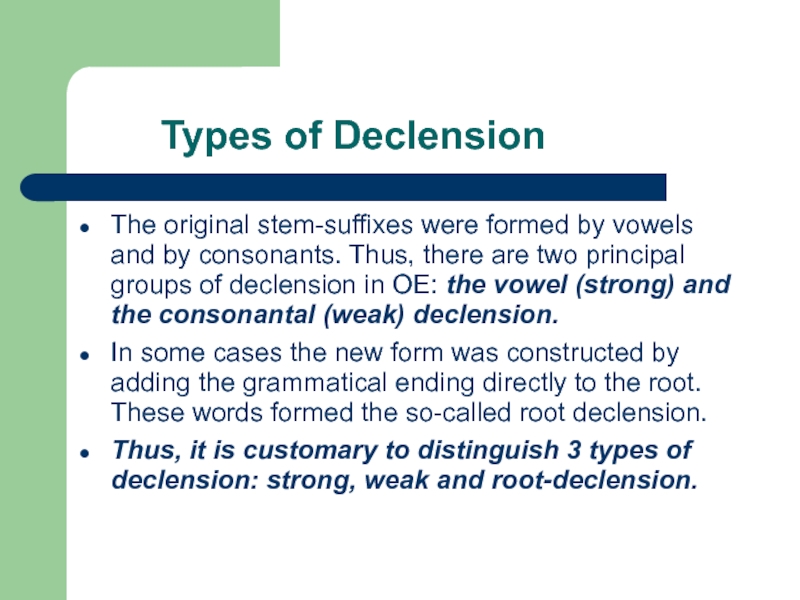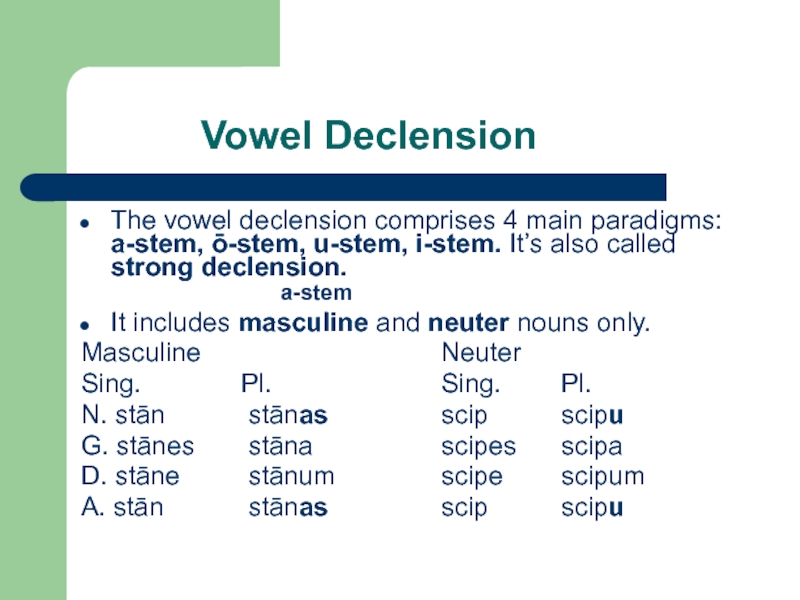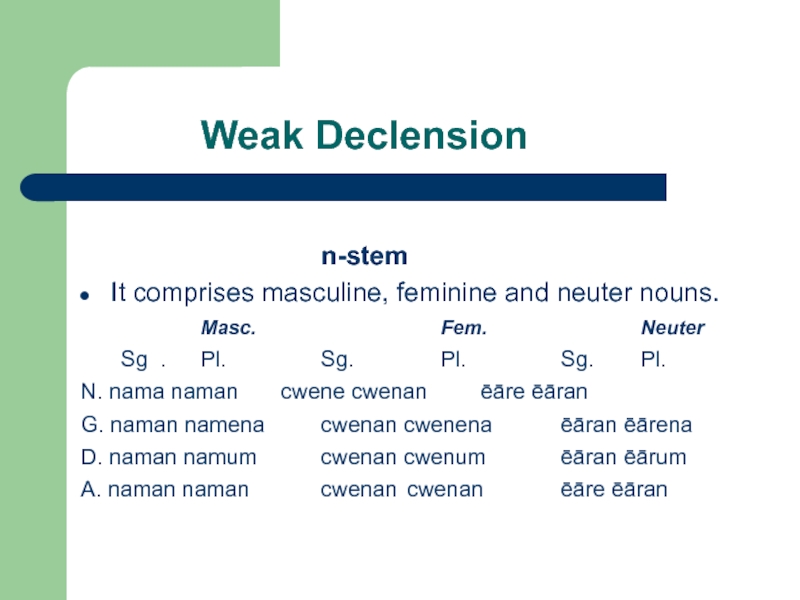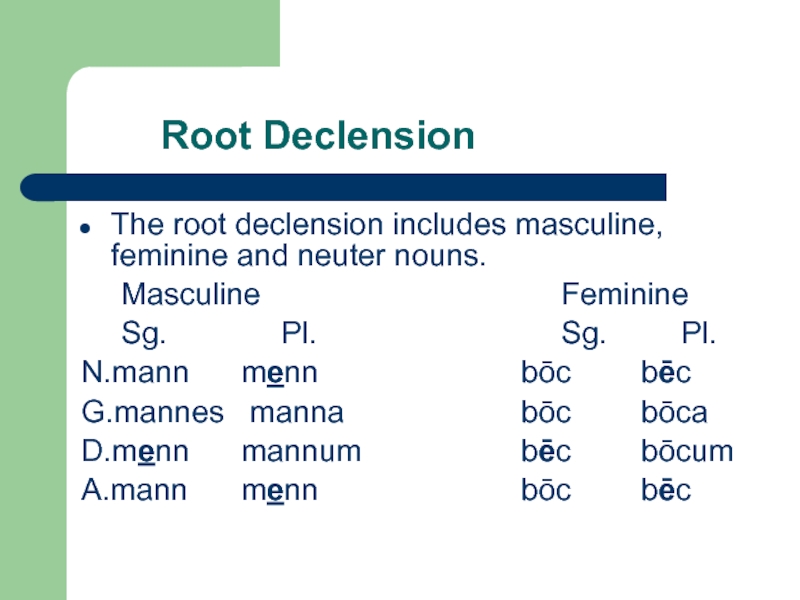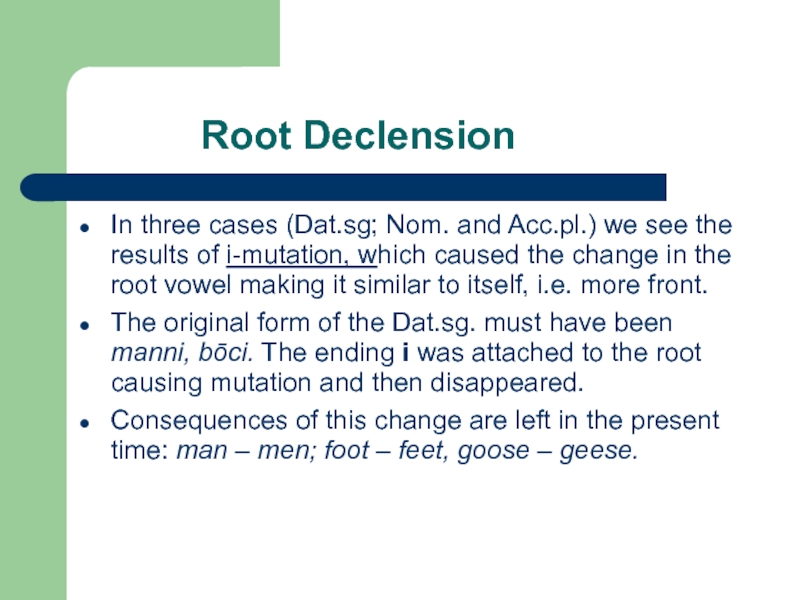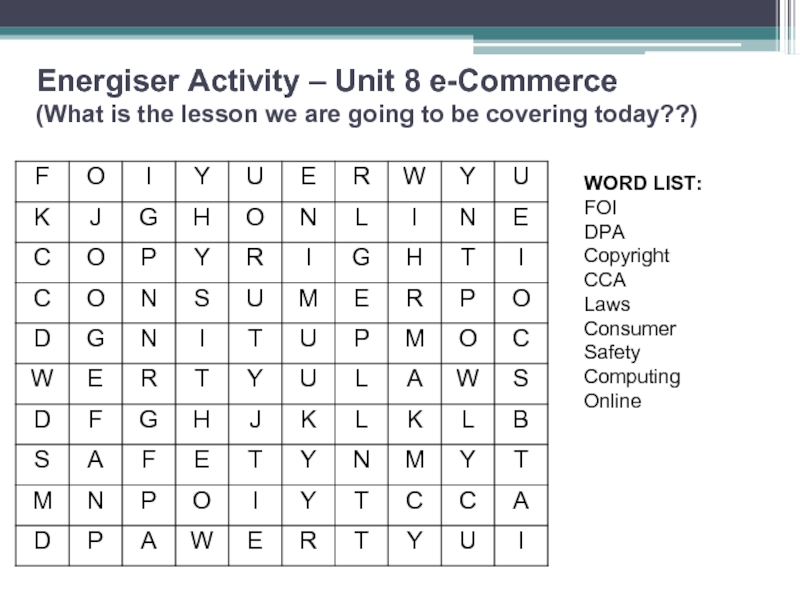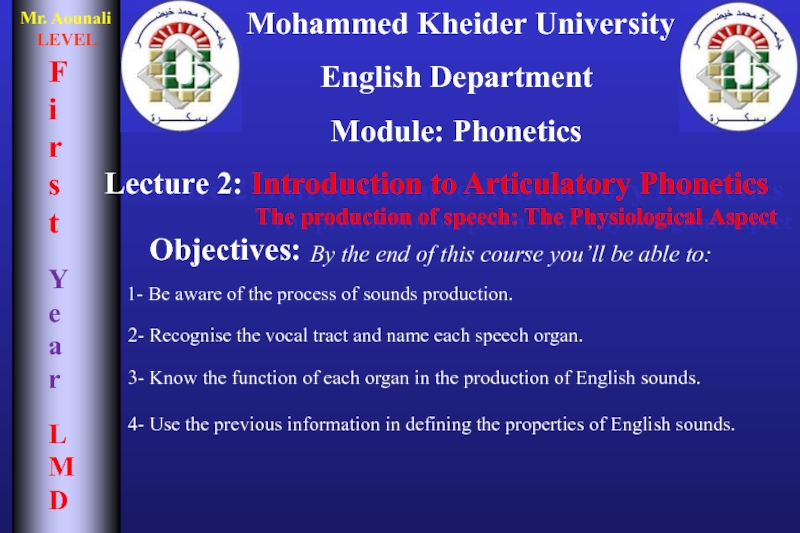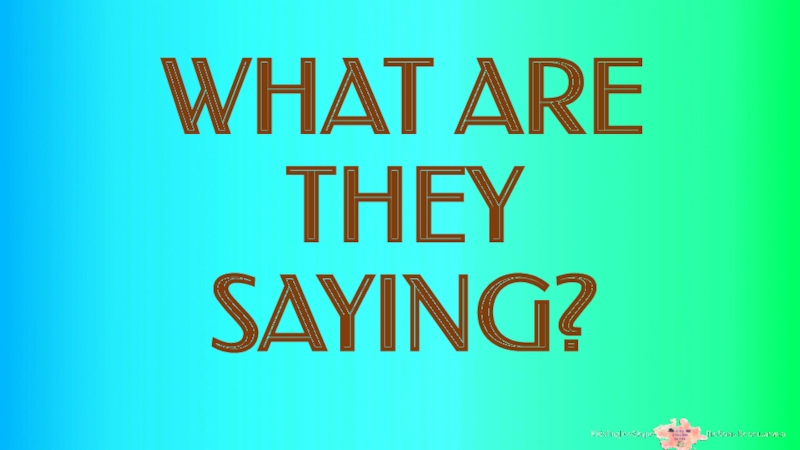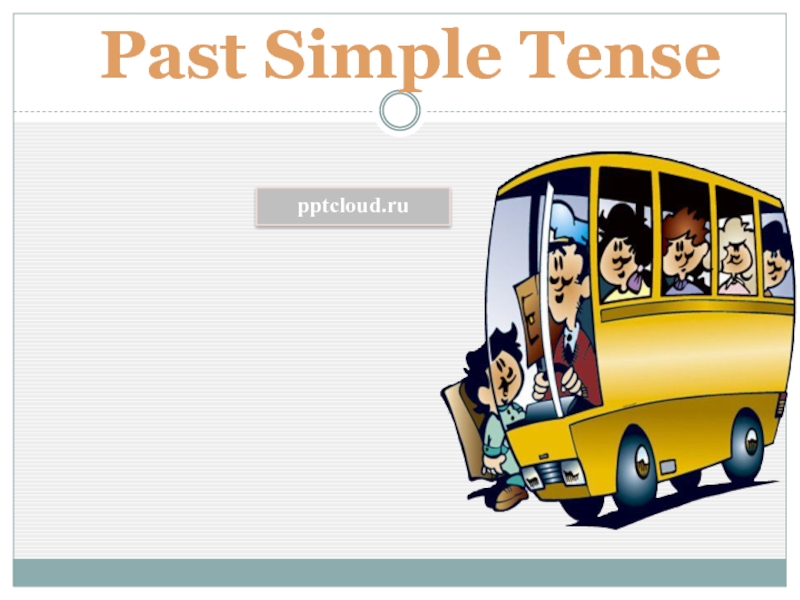- Главная
- Разное
- Дизайн
- Бизнес и предпринимательство
- Аналитика
- Образование
- Развлечения
- Красота и здоровье
- Финансы
- Государство
- Путешествия
- Спорт
- Недвижимость
- Армия
- Графика
- Культурология
- Еда и кулинария
- Лингвистика
- Английский язык
- Астрономия
- Алгебра
- Биология
- География
- Детские презентации
- Информатика
- История
- Литература
- Маркетинг
- Математика
- Медицина
- Менеджмент
- Музыка
- МХК
- Немецкий язык
- ОБЖ
- Обществознание
- Окружающий мир
- Педагогика
- Русский язык
- Технология
- Физика
- Философия
- Химия
- Шаблоны, картинки для презентаций
- Экология
- Экономика
- Юриспруденция
Old English Nouns презентация
Содержание
- 1. Old English Nouns
- 2. Gender The noun in OE had
- 3. Gender The category of gender was formed
- 4. Gender Feminine Female b-s Lifeless th-s Abstact notions dother tunʒe lufu Neuter hors scip mōd
- 5. Gender Very often OE gender corresponds to
- 6. Quantitative Changes. Shortening Sometimes a word could
- 7. Gender Some scientists (B.A. Ilyish) consider it
- 8. Number It consisted of two grammatical forms:
- 9. Case The OE noun had 4 cases:
- 10. Declension The total number of declencions exceeded
- 11. Word Structure Originally, in Proto Germanic the
- 12. Word Structure In OE grammatical endings were
- 13. Types of Declension The original stem-suffixes were
- 14. Vowel Declension The vowel declension comprises 4
- 15. Weak Declension n-stem It comprises masculine,
- 16. Root Declension The root declension includes masculine,
- 17. Root Declension In three cases (Dat.sg; Nom.
Слайд 2 Gender
The noun in OE had only two grammatical categories proper: number
and case. In addition it distinguished 3 genders.
Слайд 3 Gender
The category of gender was formed by 3 gender-forms: masculine, feminine,
neuter.
Masculine
Male beings Lifeless things Abstract notions
fæder hrōf nama
Masculine
Male beings Lifeless things Abstract notions
fæder hrōf nama
Слайд 4 Gender
Feminine
Female b-s Lifeless th-s Abstact
notions
dother tunʒe lufu
Neuter
hors scip mōd
Слайд 5 Gender
Very often OE gender corresponds to natural sex distinction. But sometimes
they didn’t coincide. For example:
OE wīf (wife) is neuter
OE wifman (woman) is masculine
OE wīf (wife) is neuter
OE wifman (woman) is masculine
Слайд 6Quantitative Changes. Shortening
Sometimes a word could be of two genders.
OE
sǣ - masculine and neuter.
If a word had two genders, it could be identified in the text by the demonstrative pronoun or adjective preceding the noun.
Sēō sǣ – f; Sē sǣ – m.
The correspondence between the meaning of the word and its gender is hard to trace. It caused different approaches to defying gender either as a grammatical or a lexical category.
If a word had two genders, it could be identified in the text by the demonstrative pronoun or adjective preceding the noun.
Sēō sǣ – f; Sē sǣ – m.
The correspondence between the meaning of the word and its gender is hard to trace. It caused different approaches to defying gender either as a grammatical or a lexical category.
Слайд 7 Gender
Some scientists (B.A. Ilyish) consider it a lexico-grammatical category as most
of the nouns belong to one gender.
Others (V.D. Arakin) find this category more grammatical than lexical as the gender is not always reflected in the sex distinctions and a noun could belong to two genders.
Some linguists (T.A. Rastorgueva) think it was merely a classifying feature accounting for the division of nouns into morphological classes.
Others (V.D. Arakin) find this category more grammatical than lexical as the gender is not always reflected in the sex distinctions and a noun could belong to two genders.
Some linguists (T.A. Rastorgueva) think it was merely a classifying feature accounting for the division of nouns into morphological classes.
Слайд 8 Number
It consisted of two grammatical forms: the singular and the plural,
which were distinguished in all the declensions with very few homonymous forms.
Nominative Singular Nominative Plural
Fisc (fish) fiscas
ēāʒe (eye) ēāʒan
tōð (tooth) tēð
scip (ship) scipu
Nominative Singular Nominative Plural
Fisc (fish) fiscas
ēāʒe (eye) ēāʒan
tōð (tooth) tēð
scip (ship) scipu
Слайд 9 Case
The OE noun had 4 cases: Nominative, Genitive, Dative, Accusative.
The Nominative
case is the case of an active agent:
þā Finnas and þā Beormas sprǣcon nēah ān ʒeþēode (the Finns and the Permians spoke nearly the same language)
Nouns in the Genetive case served as attributes to other nouns:
Þāra cyniʒa ʒetruman (the king’s armies)
The Dative case indicated the means and manner of the action:
Ōþre naman (by another name)
The Accusative case was used with nouns as direct objects denoting the recipient of the action:
sē here þæt lond ʒeēode (the army conquered the land).
þā Finnas and þā Beormas sprǣcon nēah ān ʒeþēode (the Finns and the Permians spoke nearly the same language)
Nouns in the Genetive case served as attributes to other nouns:
Þāra cyniʒa ʒetruman (the king’s armies)
The Dative case indicated the means and manner of the action:
Ōþre naman (by another name)
The Accusative case was used with nouns as direct objects denoting the recipient of the action:
sē here þæt lond ʒeēode (the army conquered the land).
Слайд 10 Declension
The total number of declencions exceeded 25. The OE system of
declensions was based on a number of features:
the stem suffix;
the gender
the phonetic structure of the word;
phonetic changes in the final syllable
The division of all nouns into types of declension in the first place rests upon the most ancient grouping of nouns according to the stem-suffixes.
the stem suffix;
the gender
the phonetic structure of the word;
phonetic changes in the final syllable
The division of all nouns into types of declension in the first place rests upon the most ancient grouping of nouns according to the stem-suffixes.
Слайд 11 Word Structure
Originally, in Proto Germanic the word consisted of 3 main
parts: the root, the stem-suffix and the grammatical ending.
In Late PG the old stem-suffixes lost their derivational force and merged with other components of the word, usually with endings.
So, in OE the word consists of two parts: the stem (the root) and the grammatical ending.
E.g. PG *fisc-a-z - Goth. fisks
In Late PG the old stem-suffixes lost their derivational force and merged with other components of the word, usually with endings.
So, in OE the word consists of two parts: the stem (the root) and the grammatical ending.
E.g. PG *fisc-a-z - Goth. fisks
Слайд 12 Word Structure
In OE grammatical endings were added straight to the root,
they had no traces of the stem-suffix as such.
Слайд 13 Types of Declension
The original stem-suffixes were formed by vowels and by
consonants. Thus, there are two principal groups of declension in OE: the vowel (strong) and the consonantal (weak) declension.
In some cases the new form was constructed by adding the grammatical ending directly to the root. These words formed the so-called root declension.
Thus, it is customary to distinguish 3 types of declension: strong, weak and root-declension.
In some cases the new form was constructed by adding the grammatical ending directly to the root. These words formed the so-called root declension.
Thus, it is customary to distinguish 3 types of declension: strong, weak and root-declension.
Слайд 14 Vowel Declension
The vowel declension comprises 4 main paradigms: a-stem, ō-stem, u-stem,
i-stem. It’s also called strong declension.
a-stem
It includes masculine and neuter nouns only.
Masculine Neuter
Sing. Pl. Sing. Pl.
N. stān stānas scip scipu
G. stānes stāna scipes scipa
D. stāne stānum scipe scipum
A. stān stānas scip scipu
a-stem
It includes masculine and neuter nouns only.
Masculine Neuter
Sing. Pl. Sing. Pl.
N. stān stānas scip scipu
G. stānes stāna scipes scipa
D. stāne stānum scipe scipum
A. stān stānas scip scipu
Слайд 15 Weak Declension
n-stem
It comprises masculine, feminine and neuter nouns.
Masc. Fem. Neuter
Sg . Pl. Sg. Pl. Sg. Pl.
N. nama naman cwene cwenan
ēāre ēāran
G. naman namena cwenan cwenena ēāran ēārena
D. naman namum cwenan cwenum ēāran ēārum
A. naman naman cwenan cwenan ēāre ēāran
G. naman namena cwenan cwenena ēāran ēārena
D. naman namum cwenan cwenum ēāran ēārum
A. naman naman cwenan cwenan ēāre ēāran
Слайд 16 Root Declension
The root declension includes masculine, feminine and neuter nouns.
Masculine Feminine
Sg. Pl. Sg. Pl.
N.mann menn bōc bēc
G.mannes
manna bōc bōca
D.menn mannum bēc bōcum
A.mann menn bōc bēc
D.menn mannum bēc bōcum
A.mann menn bōc bēc
Слайд 17 Root Declension
In three cases (Dat.sg; Nom. and Acc.pl.) we see the
results of i-mutation, which caused the change in the root vowel making it similar to itself, i.e. more front.
The original form of the Dat.sg. must have been manni, bōci. The ending i was attached to the root causing mutation and then disappeared.
Consequences of this change are left in the present time: man – men; foot – feet, goose – geese.
The original form of the Dat.sg. must have been manni, bōci. The ending i was attached to the root causing mutation and then disappeared.
Consequences of this change are left in the present time: man – men; foot – feet, goose – geese.
